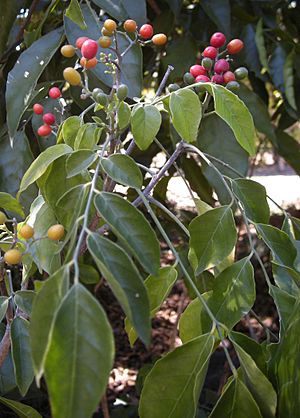Limeberry facts for kids
Quick facts for kids Limeberry |
|
|---|---|
 |
|
| Micromelum minutum fruit and foliage | |
| Scientific classification | |
| Genus: |
Micromelum
|
| Species: |
minutum
|
| Synonyms | |
|
List
|
|
The Limeberry, also known as Micromelum minutum, is a small tree or shrub that belongs to the citrus family, called Rutaceae. You can find it growing in places from India and Indochina all the way to Australia.
This plant has special leaves called pinnate leaves. This means the leaves have smaller leaf parts, called leaflets, arranged along a central stem, like a feather. These leaflets can be egg-shaped or shaped like a spear. The limeberry also has pale green or creamy flowers that smell nice and grow in big groups. Its fruits are yellow, orange, or red berries that are round or oval and grow in tight bunches.
Contents
What Does Limeberry Look Like?
The limeberry plant can grow into a tree, reaching about 10 to 20 meters (around 33 to 66 feet) tall. But it can also grow as a thick shrub and still produce flowers and fruit.
Its leaves can be up to 300 mm (about 12 inches) long. Each leaf has seven to fifteen leaflets. These leaflets are 30 to 120 mm (about 1 to 5 inches) long and 15 to 60 mm (about 0.6 to 2.4 inches) wide. Each small leaflet has a tiny stalk called a petiolule, which is up to 5 mm long.
The flowers grow in large, hairy groups that are 130 to 200 mm (about 5 to 8 inches) long. Each flower sits on a small stalk called a pedicel, which is up to 5 mm long. The petals of the flowers are pale green or creamy white and are 5 to 8 mm long. Inside each flower, there are ten stamens, which are the parts that produce pollen. These stamens are different lengths.
Limeberry plants can flower all year round. The fruit is a berry that is about 10 mm (0.4 inches) long. It changes color from yellow to orange or red as it ripens and is shaped like an oval or a sphere.
How Limeberry Got Its Name
The limeberry was first officially described in 1786 by a scientist named Georg Forster. He gave it the name Limonia minuta. This description was published in his book, Florulae Insularum Australium Prodromus.
Later, in 1834, two other scientists, Wight and George Arnott Walker-Arnott, changed its name to Micromelum minutum. They did this in their own book, Prodromus Florae Peninsulae Indiae Orientalis.
Where Limeberry Grows
The limeberry plant grows in rainforests, including drier types of rainforests and monsoon forests. It can be found from sea level up to an altitude of 600 meters (about 2,000 feet). You might also see it in rocky areas like sandstone gorges and on karst formations far inland.
This plant is found in a region called Malesia, as well as in New Caledonia, Fiji, and northern Australia. In Australia, it grows in the Kimberley region of Western Australia, in the northern part of the Northern Territory, and south from the Cape York Peninsula in Queensland. It was also recorded in New South Wales before 1911.
Limeberry and Animals
Some types of butterflies use the limeberry plant as a food source when they are young. Their larvae (which are like caterpillars) eat the leaves of the limeberry. These butterflies include the orchard butterfly (Papilio aegeus) and the canopus butterfly (Papilio fuscus).
Uses of Limeberry
In Malesia and Indonesia, people use limeberry for traditional medicine. The wood from the tree is also used for building things.
Images for kids



